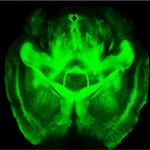imaging
3D image of a brain made transparent using the CLARITY technique. Image from: Deisseroth Lab as posted in The NY Times
I have to admit I love the science section of The New York Times. The topic today: Dr. Karl Deisseroth and colleagues at Stanford University have developed a technique called CLARITY that uses hydrogel to make the brain look like it is made of Jell-O. They have successfully applied this technique to a whole mouse brain as well as part of a human brain. Using CLARITY, they are able to observe neuronal networks three dimensionally while still maintaining the biochemistry of…
You may recall a prior post in which I talked about how intelligent crows are. In fact, there was a special on PBS demonstrating their ability to solve problems and even recognize human faces (HIGHLY recommended if you haven't yet had a chance to see it):
Watch A Murder of Crows on PBS. See more from Nature.
In a more recent study, Dr. Marzluff and colleagues used brain scans to demonstrate that crows not only remember faces, but they can also remember how they were treated by various people. In the study, his team captured 12 wild American crows while wearing latex "captor" face masks. In…
A press release from Harvard caught my eye last week, announcing results from Markus Greiner's group that were, according to the release, published in Science. The press release seems to have gotten the date wrong, though-- the article didn't appear in Science last week. It is, however, available on the arxiv, so you get the ResearchBlogging for the free version a few days before you can pay an exorbitant amount to read it in the journal.
The title of the paper is "Probing the Superfluid to Mott Insulator Transition at the Single Atom Level," which is kind of a lot of jargon. The key image is…
What's the application? Producing artificial "stars" to serve as a reference for telescopes using adaptive optics to correct for atmospheric turbulence. This allows ground-based telescopes to produce images that are as good as those from the Hubble Space Telescope.
What problem(s) is it the solution to? "How can I make this giant telescope produce even more impressive pictures?"
How does it work?The basic problem with ground-based telescopes, as anyone who has ever looked at the stars or listened to nursery rhymes can tell you, is that stars "twinkle." They appear to fluctuate in brightness…
Carl explains this:
After death, brains that do not simply disappear sometimes get smaller. In this particular fish, Sibyrhynchus denisoni the brain must have gotten a lot smaller. Check out this image, in which the braincase is in red, and the brain is in yellow. (The scale bar is 5 millimeters.)
The subject is a paper in PNAS that's available to journalists but no one else so far, yet not still embargoed ... a policy I sort of like for selfish reasons but still can't figure out. This means this link to the paper won't work for a few more days. Paper is on a 3M-year-old fossilized brain,…
Seed Magazine has a nice review of the brewing controversy over shoddy statistical methods in the field of fMRI. To some extent science is politics, this is a sexy and appealing field. A friend of mine who is a psychologist mentioned that though he doesn't think much of fMRI the head of his lab group wanted to make sure that there was always some neural imaging in their papers to increase the likelihood of acceptance. A few vivid images is worth a lot of turgid prose; even if some of the criticisms of fMRI are overblown I suspect that it was necessary that the field be brought down a few…
A few years ago I needed to image some ants for a short taxonomic paper. Lacking a decent specimen imaging system (like Entovision), I decided to snap the photos at home using my standard macro gear: a dSLR with the Canon MP-E lens. The images turned out fine and were published in Zootaxa with the paper.
Later, the Antweb team imaged the same species using their standard set-up: a high-res video camera on a Leica microscope, focus-stacking the images with specialized software. I decided to compare the two. Here they are (click on each to view the uncompressed file):
Pachycondyla…
Cicindela has been playing with scanners and saturniid moths, to great result:
The original file must be huge! Â Worth noting that Cicindela is taking a lead from Joseph Scheer, who first perfected the technique.
Heterospilus sp., head & compound eye, Costa Rica
Here are some shots from my training session this morning at the Beckman Institute's Scanning Electron Microscope (SEM). I haven't used SEM for years- wow! Great fun. Click on each image to enlarge.
Heterospilus sp. mesosoma
Heterospilus sp., ovipositor
For contrast, here's a photo of a wasp in the same genus taken with my standard Canon macro gear:
Heterospilus sp. Costa Rica, taken with a Canon 20D dSLR & macro lens
We'll be deciding over the coming months which type of images to use for our project. As you can see,…
Areolate
In 1979, Rick Harris wrote a definitive paper illustrating the various terms used by taxonomists to describe the intricate patterns on the insect exoskeleton. His guide is tremendously helpful to those of us who struggle to decide if those ridges on the head of an ant are strigate or costate. Via Sifolinia, I now see that Harris's illustrations are available online:
A Glossary of Surface Sculpturing
Incidentally, Rick was the guy who taught me how to use a Scanning Electron Microscope, although at this point it'd be a minor miracle if I remembered any of it.
